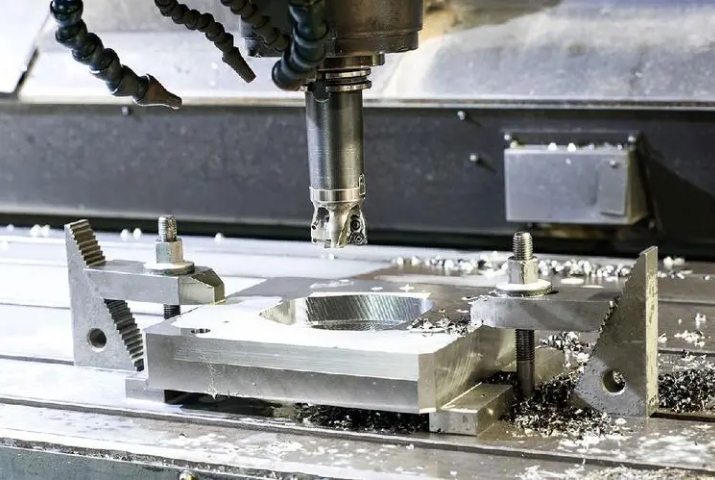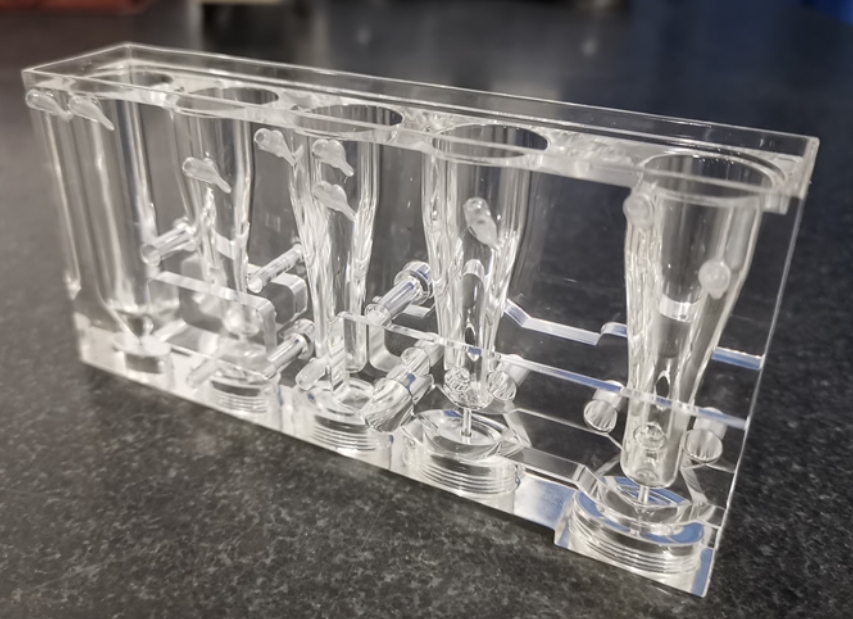CNC machining has become an integral part of the medical industry, playing a pivotal role in the manufacturing of a wide range of medical devices and instruments. The precision, consistency, and complexity that CNC technology offers are unmatched compared to traditional manufacturing techniques, making it invaluable in a domain where accuracy can mean the difference between life and death.
1. What are the CNC machining methods commonly used in the medical sector?
Milling
This is the most common CNC machining method used in the medical sector. It involves using a rotating cutting tool to remove material from a workpiece.
Turning
This method is used to create cylindrical parts such as implants, prosthetics, and surgical instruments. It involves rotating a workpiece while a cutting tool removes material along its length.
Drilling
This method is used to create holes in medical devices such as orthopedic implants and surgical instruments. It involves using a drill bit to remove material from a workpiece.
Grinding
This method is used to create smooth and precise surfaces on medical devices such as surgical instruments and implants. It involves using an abrasive wheel to remove material from a workpiece.
EDM (Electrical Discharge Machining)
This method is used to create complex shapes and intricate designs on medical devices such as orthopedic implants and surgical instruments. It involves using electrical discharges to remove material from a workpiece.

2. How does CNC Machining benefit the medical sector?
CNC (Computer Numerical Control) machining significantly enhances the accuracy and precision of medical device manufacturing. This technology operates with extremely high precision through pre-set programming codes and software control, greatly minimizing the potential for human error. Compared to traditional manual machining methods, CNC machining achieves micrometer or even nanometer precision, which is crucial for producing high-precision medical devices such as heart stents and artificial joints. Enhancing manufacturing precision directly relates to the safety and efficacy of these devices for patients, making CNC machining indispensable in improving patient outcomes.
Enhancing Efficiency
In terms of production efficiency, CNC machining offers significant improvements over traditional manual or semi-automatic machining methods. CNC machines can operate unattended for extended periods and at speeds far exceeding traditional methods. Moreover, with a high degree of automation, once the program is set, the machine can continuously reproduce products of consistent quality, substantially reducing the production cycle. This efficiency boost not only cuts down on time costs but also means more products can be produced in the same amount of time, effectively lowering the cost per unit.
Supporting Customization
The strength of CNC machining lies in its ability to easily facilitate customization. In the medical field, where each patient's condition varies, there is an increasing demand for personalized medical devices and implants. CNC machining can quickly adjust and set processing parameters according to a patient's specific needs, producing devices that perfectly meet those requirements. This customization capability significantly enhances patient satisfaction and comfort while also improving treatment outcomes.
Ensuring Consistency
During the production process, CNC machining ensures strict consistency in product quality and dimensions. Every product is manufactured to the same standards and specifications, greatly reducing the defect rate caused by product variations. This repeatability is particularly important for mass production, ensuring that every product meets stringent medical standards and thereby enhancing the overall reliability of the products.
Reducing Waste
CNC machining also features high material utilization. With precise control and efficient programming, CNC machines minimize waste of raw materials. This not only helps reduce material costs but is also beneficial from an environmental and resource sustainability standpoint. By optimizing cutting paths and reducing unnecessary machining processes, CNC machining provides an effective pathway for green manufacturing.
3. What are common materials used in CNC machining in the medical industry?
Stainless Steel
Stainless Steel
It is one of the most widely used materials in the medical industry due to its excellent corrosion resistance, strength, and biocompatibility. It is often used for surgical instruments, implants, and other medical tools.
Titanium and its Alloys
Titanium is favored for its high strength-to-weight ratio, excellent biocompatibility, and corrosion resistance. It is commonly used in orthopedic implants such as hip and dental implants.
Aluminum
It is used in various medical instruments and devices due to its light weight, strength, and ability to resist corrosion.

Cobalt-Chrome Alloys
These alloys are known for their exceptional wear resistance and strength, making them suitable for load-bearing implants like hip and knee replacements.
Polymers
High-performance plastics such as PEEK (Polyether Ether Ketone), PTFE (Polytetrafluoroethylene), and PE (Polyethylene) are increasingly used in medical devices due to their chemical resistance, durability, and biocompatibility. They are often used in implants and minimally invasive surgical devices.
Ceramics
Biocompatible ceramics like zirconia and alumina are used in certain types of implants due to their hardness, wear resistance, and biocompatibility.
Delrin
This is a type of acetal resin used for its strength, stability, and biocompatibility. It is often used in gears and bearing applications within medical devices.
Copper and Copper Alloys
These materials are used in certain medical applications for their antimicrobial properties, electrical conductivity, and mechanical attributes.
Nitinol
An alloy of nickel and titanium, nitinol is notable for its shape memory effect and superelasticity, making it useful for applications such as stents and surgical tools.
Glass and Glass-Ceramics
These materials are used in certain medical applications, such as laboratory equipment and containers, due to their chemical inertness and transparency.
4. What are key challenges in CNC machining for the medical industry?
Material Properties
Medical-grade materials, such as certain metal alloys, ceramics, and high-performance plastics, can be difficult to machine due to their hardness, brittleness, or tendency to work-harden. This necessitates the use of specialized tools, coolants, and machining parameters.
Precision and Tolerance
Medical devices often require extremely tight tolerances and surface finishes to ensure proper fit, function, and longevity. Achieving these levels of precision consistently can be challenging and requires skilled operators and advanced machinery.
Complex Geometries
Many medical devices, such as joint replacements and dental implants, have complex three-dimensional shapes that must be accurately reproduced. Machining these complex parts requires sophisticated programming and machine capabilities.
Regulatory Compliance
The medical industry is heavily regulated, with strict standards for material biocompatibility, sterilization, and traceability. Manufacturers must ensure that their CNC machining processes do not introduce contaminants or compromise the integrity of the materials.
Cleanroom Requirements
Some medical devices require manufacturing in a cleanroom environment to avoid contamination. This can impose restrictions on the type of lubricants and coolants used during machining and may require additional cleaning or sterilization steps.
Quality Assurance and Validation
Ensuring consistent quality and validating the machining process for each medical part can be labor-intensive and time-consuming. This involves extensive documentation, process validation, and often requires pre- and post-machining inspections.
Cost Pressures
Despite the need for high precision and quality, there is often pressure to control costs, especially for disposable or single-use devices. This necessitates efficient machining processes and waste reduction strategies.
Adapting to New Technologies
As new materials and designs emerge, CNC machines and processes must adapt to accommodate them. This requires ongoing training, equipment upgrades, and process development.
Batch Size Variations
The medical device industry can have a wide range of production volumes, from custom-made prosthetics to mass-produced disposable items. CNC machining processes must be flexible enough to adapt to different batch sizes efficiently.
Data Security and Integrity
With the increasing use of digital technologies and networked machines, ensuring data security and integrity becomes crucial to prevent unauthorized access or manipulation of device designs and manufacturing parameters.
5. Future trends in CNC machining for medical applications
Smart Manufacturing
The integration of industrial internet of things (IIoT) technologies into CNC machines will allow for greater monitoring and control of the manufacturing process. This can lead to improved efficiency, reduced downtime, and enhanced product quality.
Additive Manufacturing Integration
The combination of CNC machining with additive manufacturing (3D printing) will enable the creation of more complex and optimized designs. This hybrid manufacturing approach can conserve material, reduce weight, and improve functionality.
Advanced Materials
The use of new and improved materials, such as biocompatible alloys, advanced ceramics, and composites, will require CNC machines to adapt with new tooling and machining strategies.
Enhanced Automation
Fully automated machining cells with robotic loading and unloading, automatic tool changing, and in-process gauging will become more common. This will improve consistency and free up personnel for more complex tasks.
Digital Twin Technology
The use of digital twins, virtual replicas of physical devices or systems, will enable manufacturers to simulate CNC machining processes and optimize them before physical production begins.
Adaptive Machining
CNC machines with adaptive control capabilities will be able to adjust their cutting parameters based on real-time feedback from the machining process, improving accuracy and reducing human input.
Eco-Friendly Processes
There will be a greater emphasis on sustainable manufacturing practices, including the use of environmentally friendly lubricants and coolants, energy-efficient machines, and recycling of machining waste.
Improved Quality Assurance
Advanced in-process monitoring and inspection technologies, such as laser measurement systems and machine vision, will provide higher quality assurance and reduce the need for offline inspections.
Customization and Personalization
CNC machining will continue to enable the customization of medical devices to fit individual patient needs, aided by sophisticated design software and flexible manufacturing techniques.
Data Analytics and Artificial Intelligence
The use of AI and machine learning algorithms will help analyze vast amounts of data generated during the CNC machining process, optimizing operations and predicting maintenance needs.
Security and Cybersecurity
As CNC machines become more connected, securing them against cyber threats will become increasingly important to protect both the intellectual property of device designs and the integrity of the manufacturing process.
Skillset Evolution
The workforce will need to evolve with these technologies, requiring continuous education and training in advanced CNC programming, machine operation, and process optimization.
In summary, CNC machining plays a pivotal role in the medical industry by offering precision, efficiency, and flexibility in the manufacturing of a wide range of medical devices and components. From orthopedic implants and dental prosthetics to surgical tools and custom-fitted devices, CNC technology enables the accurate realization of complex designs and geometries with tight tolerances and high-quality surface finishes.
Post time: Jun-26-2024
